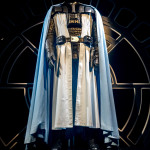
Infrared and color photos of the costumes shown at the „Star Wars Identities“ exhibit, Cologne, Germany
Let me start by explaining what an „infrared photo“ is, because many explanations – even those spread by the media – are wrong.
An infrared photo – which, namely, is a photo which is taken using a camera which is converted to a specific wavelength (in my case, 700nm) of the infrared range – is not a „thermal photo“.
You’ve probably seen those a lot – the photos that show, for example, the heat emitted by bodies or houses in certain colors. That isn’t „infrared“; it’s just that the thermal imaging basically uses an infrared thermometer to determine the temperature of parts of what it’s being pointed to.
Infrared photography, on the other hand, „sees“ the amount of infrared light being reflected from materials. This is not necessarily related to the color the materials have been dyed to (or naturally have). For example, trees and plants show up as bright white in infrared photography.
Natural fibers, in general, show up more „white“; while artificial fibers, such as polyester, show up as „blue-ish“.
You see why and how that is interesting in terms of analyzing original costumes: With infrared photos, you don’t have to „guess“ what a costume is made of (or rather, if the fabric was woven from natural (i. e. silk, cotton, wool) or artificial (i. e. Polyester, Acetate) fibers.
The camera I use to take photos like these is a converted Nikon D3200. It’s „converted“, as in: the hotmirror filter (which is usually in place on all cameras with the purpose of keeping infrared rays away from the sensor!) has been removed and replaced with a hormirror filter that keeps away anything that isn’t at 700nm from said sensor.
I have another camera to take „regular“ photos, but the converted D3200 can do nothing but take infrared photos (which, however, it does very well!).
So what you are seeing here is not a „photoshop effect“. It’s also not something that I (or anyone else) would be able to reverse.
I went to the exhibit with both cameras and used both; but ended up taking more pictures with the IR camera than with the regular camera, because, you know, there are tons of photos other people took with regular cameras; but – as far as I know – mine are the only ones that have been taken with an infrared camera at that particular exhibit.
A very nice example is the comparison between Darth Vader’s costume in „regular“ versus „infrared“ photos:
| Color (regular) photo | Infrared Photo |
 |
 |
While it COULD seem in the regular photos (as well as in person), that cloak and tunic are the same material – maybe just a bit off by different color dyes – the IR photo clearly shows that they are not the same material.
The tunic is distinctively white, while the cloak as well as it lining are blue.
See below for information.
So after introducing you to what IR photos actually are, and what they can show you, I hope you’ll have fun looking at the costume at the exhibit with „infrared vision“ – this is, by the way, the way snakes and scorpions would see them as well. Bees, on the other hand, „see“ the other end of the light spectrum – UV, to be precise.
| Costume | Color | Infrared | Analysis |
| Darth Maul | 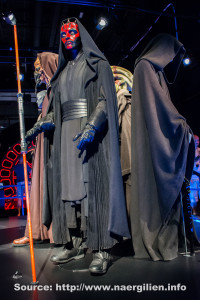   |
 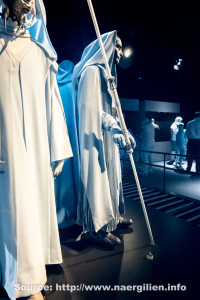  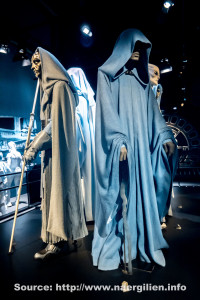   |
The infrared photos prove that coat, tabards, mid robe, under tunic and pants are ALL made from different materials; indicated by their slightly different colors in the IR photos.
This is something I had already suspected when creating my own reproduction of this costume; but it’s nice to be able to scientifically prove it 😉 Mid robe and tabards might have a bit of artificial fiber content (indicated by the blueish color); though, in this case – as the material, in texture and appearance, very much looks like „old“ style silk bourette – could also be attributed to a certain kind of dye; which would have been used to prevent the material from bleaching out in the sun while filming in the desert. |
| Darth Maul: Comparing regular and infrared photos |
 |
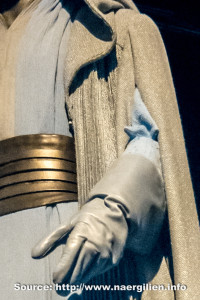 |
Comparison of regular and infrared photo of the materials. Note how well the coat material shows in infrared, opposed to the „regular“ photo, in which you can’t really recognize the weave. Also note that the gloves are – surprisingly – not leather (because that, like the belt, would show as black). I think what we’re looking at here are vinyl / pleather gloves! |
| Darth Maul: Backside |
 |
 |
Background shows Darth Maul’s costume from behind; with the „V“ yoke on the coat clearly visible. |
| Darth Maul: Sleeve shape |

|
  |
Curved overall shape and squared bottom end of sleeve on Darth Maul (left side of pictures) |
| Luke Skywalker |  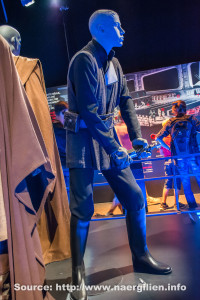 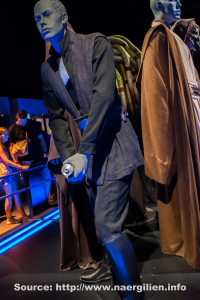   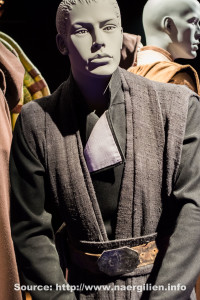  |
    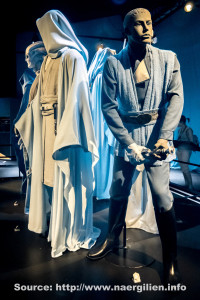 |
I can’t even begin to say how fascinated I was by the materials in this costume, which really don’t show up so well on screen. See below for a materials analysis. |
| Luke Skywalker: Details |
  |
Very good pictures of the structure of all three fabrics: Linen on the white inside lapel; a twill weave (probably cotton) for the tunic, and either a linen or raw silk fabric for the tabards. Bottom photo shows the sewn, pintucked stripe on the pants. |
|
| Darth Vader |  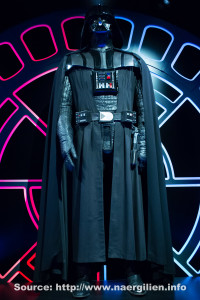 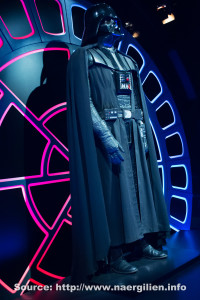 |
   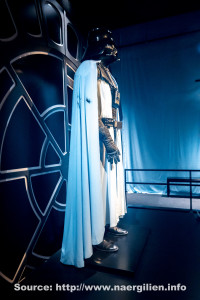   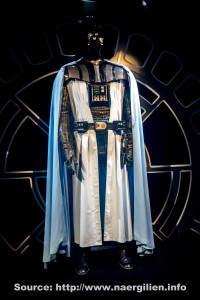 |
The infrared photos show pretty clearly that the tunic is not the same material as the cloak. I’d say that the tunic is a natural fiber, i. e. wool or cotton, while the cloak is probably polyester, with a polyester satin or taffeta lining. |
| Darth Vader: Details |
 |
You can see that the tunic is machine topstitched (=not blindstitched at hem and front opening) | |
| Emperor Palpatine / Darth Sidious (Black) |      |
    |
The infrared photos which were taken straight from the front show the lining inside the sleeves very well (at the bottom inside of the sleeves) – it shows up as much lighter than the outer material.
The interesting thing is that the robe has been cut in ONE PIECE. Note that if you don’t have access to, like, at least 2-2.5 yards WIDE fabric (and ~4.5 yards of that!), this kind of construction is pretty much impossible to accomplish, in case you would like to reproduce the exact look. I’ll be honest – if I had known about the „entire coat being one piece of fabric“ thing when I started my own reproduction, I would have been in a horrible dilemma because I would seriously have required that unusually wide fabric.
|
| Senator Amidala: „Final Senate“ (Episode 3) |          |
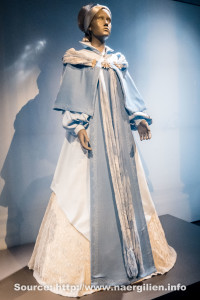         |
Two things really surprised me:
I would have been happier if I had known all those things before creating my own reproduction of this gown; but as it is, my reproduction is finished; and it’s not the worst reproduction, if I may say so 😉 |
| Queen Amidala: Parade Gown (Episode 1) |    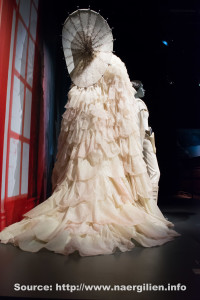   
|
 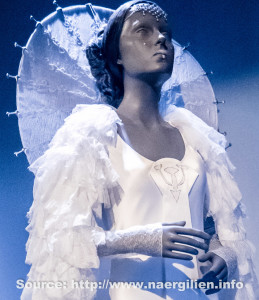      |
See material analysis below! |
| Parade gown: Details |
  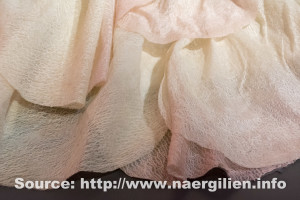  |
The material used for the gown is interesting; and seriously not as simple as it looks at first sight. It’s NOT „crinkled chiffon“. I first thought that it basically was wavy fibers, ironed to a netting: Then I saw the sleeve. You can clearly see that those „fibers“ don’t go all the way. I’ve seen that before – it’s basically (very!) distressed silk organza. The distressing (which can be achieved with a moderately hard brush used on wet fabric) pulls the fibers apart, creating the „wavy“ appearance. It should also be noted that the „wavy“ part happens along the grain of the fabric; which shows that, for example, the sleeve has been cut on the bias. Many of the petals on the coat are also cut on the bias (see last two pictures). The „distressed“ organza has been ironed to a stabilizing netting. That kind of „netting stabilizer“ is rather rare, but it exists (and is mostly used by to prevent antique clothing from tearing / fraying). Its purpose, in this case, is clear: To prevent the distressed organza from fraying even more. |
|
| Padmé Geonosis Arena, Ep. 2 |
  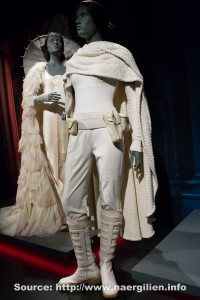 |
  |
|
| Leia: Slave – Episode 6 |   |
 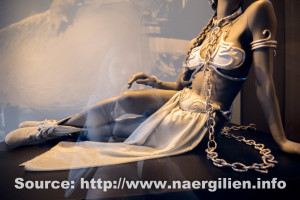  |
|
| Leia: Hoth – Episode 5 | 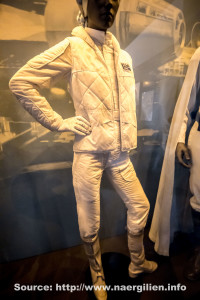 |
||
| Han Solo / Chewbacca |   |
||
| Lando Calrissian |    |
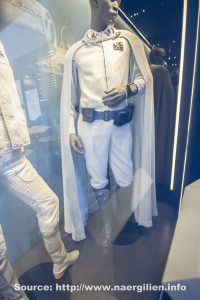 |
|
| Yoda (Ep. 6) |   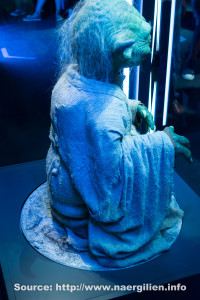 |
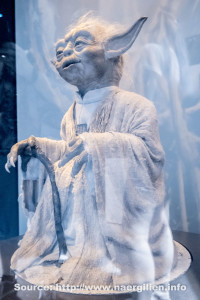    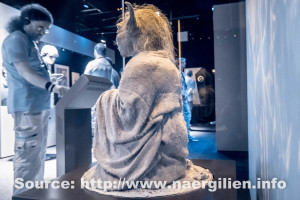  |
Note the beautiful distressed raw / tussah silk robe! |
| Boba Fett | 
|
 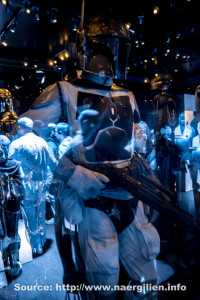 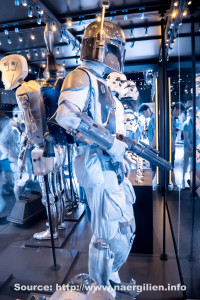 |
|
| Tusken |   |
    |
Very pretty: The chevron / zigzag weave of the fabric; which makes for some nice structure. |
| Jawa |  |
 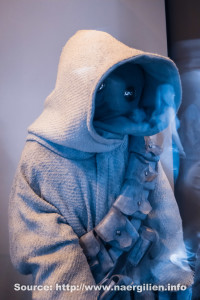       |
The first infrared picture shows the actual structure of the mask rather well – which you pretty much cannot see in „color only“ photos. As the mask is, obviously, covered with a natural fabric, the infrared photo shows the fabric lighter than it is in reality, therefore revealing what the mask actually looks like. As I have already mentioned on my Jawa costume reproduction page, the fabric is, pretty obviously, twill-woven coffee sacks. |
| Various (unsorted) |   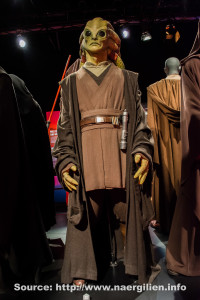  |
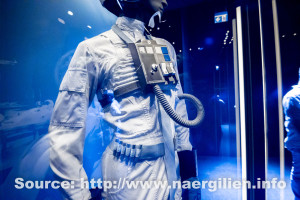  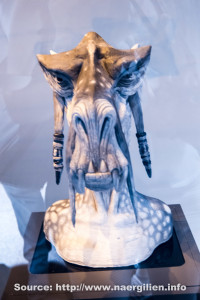    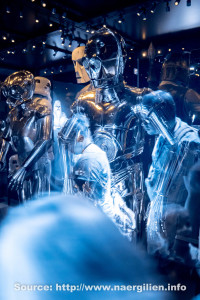    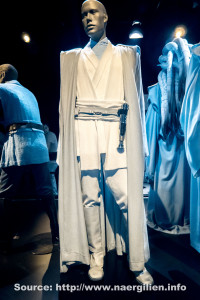 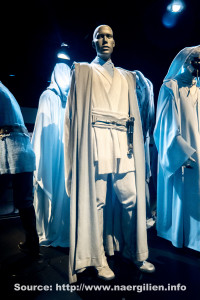 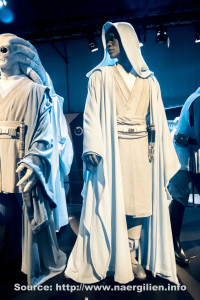 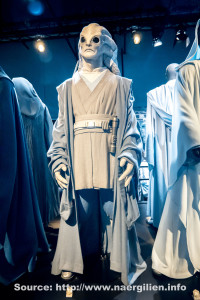  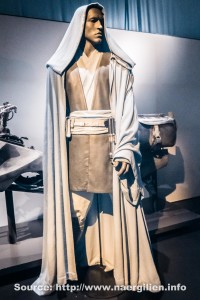 |
Obi-Wan Kenobi, Anakin Skywalker, rebel pilots and others. |
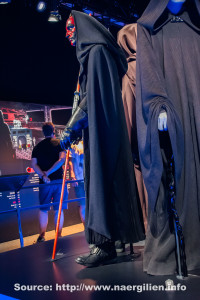
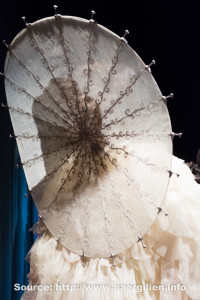
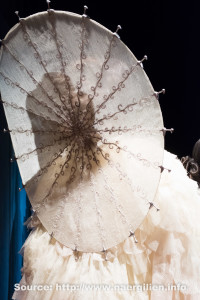
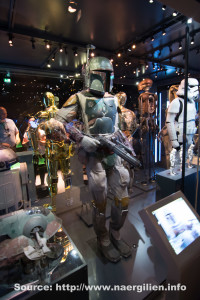
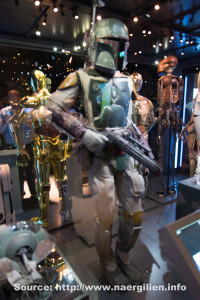
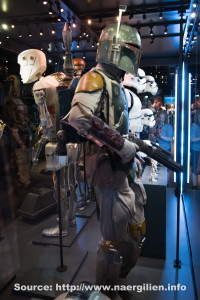

Several pieces on the costume are likely mismatched especially on older costumes. The ROTJ Vader is wearing a ESB style surcoat as an example. LFL has not taken great care of costumes until recently and there are many derivatives of each piece. Vader had multiple hero and stunt capeset so concluding materials are different now doesn’t help establish any new providence for those pieces.
…. Mir fehlen die Worte. Unglaublich! Deine Recherchearbeit ist einfach ein Wahnsinn – danke, danke, DANKE dass du sowas kostenlos zur Verfügung stellst. Einfach großartig!
Naja,
kostenlos ist immer noch besser als umsonst 😉